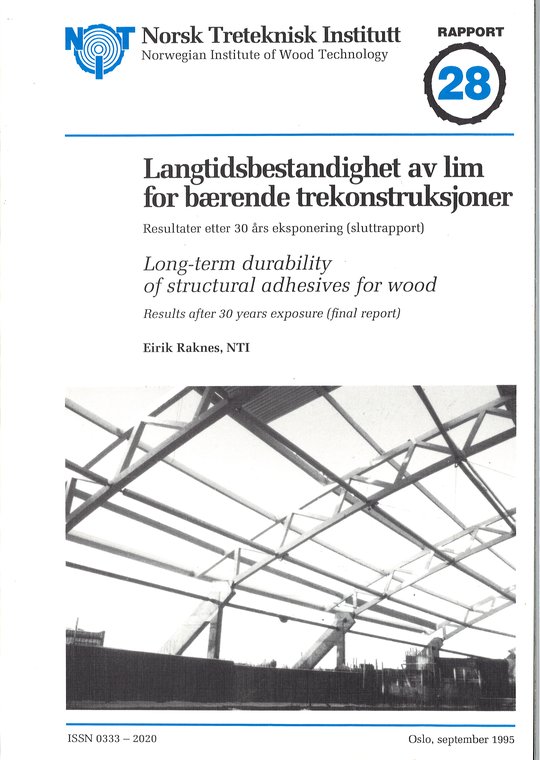28: Langtidsbestandighet av lim for bærende trekonstruksjoner
Forfatter: Eirik Raknes
Rapport 28, 1995
32 s.
200,- (Gratis for medlemmer)
Last ned
Sammendrag
Dette er sluttrapport fra et forsøk som ble startet i 1964, der man har undersøkt langtidsbestandigheten til lim av følgende typer: Kaseinlim (2 merker), modifiserte urealim (3 merker), vanlige urealim med fyllstoff (5 merker), syreherdende fenollim (1 merke), resorcinollim (1 merke), fenolresorcinollim (2 merker). Prøver er eksponert i tre inneklimaer (30 år), samt under tak ute (22 år) og ubeskyttet ute (10 år). Ut fra resultatene trekker vi følgende konklusjoner når det gjelder de enkelte limtypers langtidsbestandighet:
- Kaseinlim er velegnet til bruk i bærekonstruksjoner som skal stå innendørs eller utendørs under tak. Konstruksjonene bør beskyttes mot vann i byggetiden.
- Vanlige urealim m. fullstoff har beholdt tilfredsstillende tørrstyrke innendørs og utendørs under tak. Vannbestandigheten går imidlertid nedover. Dette er bekymringsfullt, da det kan bety at også tørrstyrken vil bli redusert etter hvert, Disse lim må ansees for tvilsomme, selv om de nå er tillatt brukt i Europa til innendørskonstruksjoner (Eurocode 5, EN 301).
- Modifiserte urealim har gitt bedre resultater enn de vanlige, og de furfurylmodifiserte har fortsatt tilfredsstillende tørrstyrke såvel som vannbestandighet, mens vannbestandigheten nå er litt under kravet for lim nr. 10. Dette lim ga imidlertid best resultat av UF-limene ved utendørsprøvingen. Både disse resultater og resultatene i (9) tyder på at man kan få frem egnede urealim ved modifisering som gjør limsubstansen mer fleksibel og mindre sprø. Slike lim er egnet til bruk innendørs og utendørs under tak.
- Syreherdende fenollim. Lim av liknende type som var med i dette forsøket er uegnet til bruk i bærekonstruksjoner.
- Resorcinol- og fenolresorcinollim er velegnet til bruk i bærende trekonstruksjoner både innendørs og utendørs.
Summary
This is the final report from an experiment where the long-term durability of 14 different adhesives has been investigated over a period of 30 years. The adhesives are listed in table 1. Samples (fig. 1) were exposed as follows:
- 20 ºC/65 % RH. (30 years.)
- Outdoors protected by roof. (22 years).
- Unheated, ventilated loft. (30 years.)
- Cellar. (30 years.)
- Unprotected outdoors (not caseins), 10 years.
The experiment is described in detail in ref. (1), which is a progress report after 2 years exposure.
Test results after 6, 10, 15 and 22 years are given in ref. (2)-(5), and after 15 years in (6). This report contains test results after 30 years natural ageing indoor, using test pieces as shown in fig.1 Woodspecies: Spruce (Picea abies).
Results from delamination tests (ASTM D1101-59) are given in table 2 and fig. 2 and 3, and results from dry block shear tests (ASTM D905-49) are given in table 3 and fig. 4 and 5.
An evaluation of the results is given in table 4.
Samples of the various adhesives were examined microscopically. The appearance of the gluelines fit very well into the categories described by River & al. (9).
The ordinary UFs with inert fillers (no. 5-9) gave type l-gluelines, i.e. they were crazed, Example: Fig. 8. The modified UFs, no, 3, 4 and 10, generally gave type II gluelines, with transverse but not longitudinal cracks. Example: Fig. 9. In some areas these gluelines were without cracks (type III). Example: Fig. 7.
Caseins (fig, 6), resorcinols, phenol-resorcinols (fig. 11) and acid phenolic (fig. 10) gave type lll-gluelines, without cracks.
The following conclusions are drawn considering the various adhesives:
- Caseins (no. 1 and 2) have retained their dry strength more or less unchanged throughout the experiment for indoors and outdoors under roof exposure. (Wet strength and unprotected outdoor exposure were not tested.) These adhesives are considered suitable for indoor and protected outdoor wood constructions. They should be protected against water during the building period.
- Straight UFs with inert fillers (no. 5-9) seem to post-cure the first two years, and then develop curing stresses during the 2-6 year period. This causes a reduction in the (observed) shear strength. A relaxation seems to take place in the 6-10 year period, probably because the adhesive layers crack transversely as well as longitudinally. The observed dry shear strength increased in this period, and has since then been more or less constant.
The crazing of the gluelines have, obviously, reduced the wet strength of the wood at the glue-wood interface, This was observed also by River & al. (9). The wet strength decreases steadily, which could mean that ultimately also the dry strength will be affected.
These adhesives should therefore be considered with suspicion. - Modified UFs (no. 3, 4 and 10) have stood up better than the straight ones, especially the furfurylated brands (no. 3 and 4). For these the shear strength as well as the water resistance are still satisfactory. The resorcinol modified one, however, showed the best results in outdoor exposure.
Our results, as well as the results in (9) indicate that it is possible to make satisfactory UFs by making them more flexible and less brittle through suitable modifications. Such adhesives would be suitable for indoors and protected outdoors constructions. - Acid phenolic of the type tested here must be considered unsuitable for structural wood gluing, probably due to acid damage of the wood.
- Resorcinols and phenol-resorcinols are suitable for structural use indoors as well as outdoors.
If these results are compared with accelerated tests carried out at the beginning of the experiment, the correlation is now quite good. It should therefore be possible to design a temperature/humidity cycling which in combination with glueline examination could make forecast as for the durability of UF adhesives.
